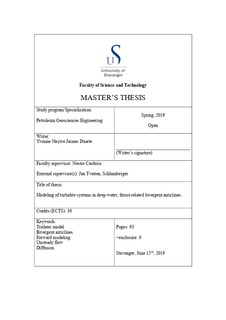| dc.contributor.advisor | Cardozo, Nestor | |
| dc.contributor.author | Jaimes Duarte, Yvonne | |
| dc.date.accessioned | 2019-09-30T12:19:57Z | |
| dc.date.available | 2019-09-30T12:19:57Z | |
| dc.date.issued | 2019-06 | |
| dc.identifier.uri | http://hdl.handle.net/11250/2619400 | |
| dc.description | Master's thesis in Petroleum Geosciences Engineering | nb_NO |
| dc.description.abstract | In deep-water fold and thrust belts, thrust-related folds that switch vergence along strike can occur and are considered to have a major impact on reservoir distribution (Higgins et al., 2009). Syn-sedimentary processes resulting from the initiation and propagation of these structures modify the sediments distribution and deposition, as well as the channels pathways. In this thesis, forward modeling is applied to simulate seven cases related to two listric, oppositely verging thrusts that initially grow separately but with growth, they link. The model is implemented by coupling two independent but related models. A pseudo-3D trishear model, which simulates the kinematic growth of the thrust-related anticlines in terms of parameters such as fault slip, trishear angle, and fault propagation to slip ratio; and a forward stratigraphic model (GPM), which simulates geomorphological variations as result of sediment transport and erosion in a deep-water, turbidite setting.
The obtained models reveal that: a) the variation of the structure's center of curvature (Case 1 to 4) affects the confinement, migration and direction of the flow. After overpassing the structures the sediment distribution over the fan developed area can be i) a cone-shape fan elongated in the flow direction and ii) symmetrical cone-shape fan perpendicular to the strike of the structures; b) decreasing the TA and the P/S of one thrust with respect to the other (Case 5 and 6) can block and deflect the flow. The blocking and posterior deflection favor the sediments transported by the unsteady flow to be accumulated as amalgamated sand-rich layers, which are deposited and trapped against the structure. However, diffusion results do not suggest preferential deposition of possible reservoir units adjacent to the anticlines; and, c) decreasing the timestep (Case 7), provide more time to the sediments to be mixed. It creates a more heterogenous reservoir (if existing) with a potential decrease in petrophysical properties. These results highlight the sensible response of sedimentation to active deformation since the flow pathway is continuously deflected, blocked or both.
Forward modeling techniques provide a better understanding of geological processes through time in order to perform predictive analysis of prospective sand-rich layers distribution. In addition, present an alternative exploration approach that can be applied in frontier zones where exploration data is limited. | nb_NO |
| dc.language.iso | eng | nb_NO |
| dc.publisher | University of Stavanger, Norway | nb_NO |
| dc.relation.ispartofseries | Masteroppgave/UIS-TN-IER/2019; | |
| dc.rights | Navngivelse 4.0 Internasjonal | * |
| dc.rights.uri | http://creativecommons.org/licenses/by/4.0/deed.no | * |
| dc.subject | petroleumsgeologi | nb_NO |
| dc.subject | Trishear model | nb_NO |
| dc.subject | petroleum geology | nb_NO |
| dc.subject | bivergent anticlines | nb_NO |
| dc.subject | petroleum geology | nb_NO |
| dc.subject | diffusion | nb_NO |
| dc.subject | forward modeling | nb_NO |
| dc.subject | unsteady flow | nb_NO |
| dc.title | Modeling of turbidite systems in deep-water, thrust-related bivergent anticlines | nb_NO |
| dc.type | Master thesis | nb_NO |
| dc.subject.nsi | VDP::Technology: 500::Rock and petroleum disciplines: 510::Geological engineering: 513 | nb_NO |
| dc.subject.nsi | VDP::Mathematics and natural science: 400::Geosciences: 450::Petroleum geology and petroleum geophysics: 464 | nb_NO |

